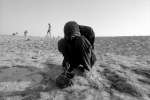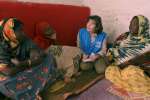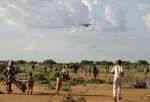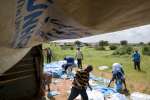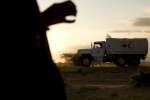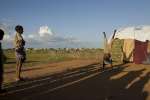Talented Somali refugee dreams of new life in America to honour slain father who set up Picasso art school
News Stories, 27 July 2015
ADDIS ABABA, Ethiopia, July 27 (UNHCR) – It has been said that if you suffer for your art, you will never die. For 16-year-old Abdirahim Abdulkadir Osman, a talented Somali refugee artist, it is the memory of his father's brutal murder that keeps his dreams of a better life in America alive.
It was June 2009 when Al Shabaab gunmen forced their way into the home of his father, a teacher and co-founder of the Picasso Art School in Mogadishu. They shot him, along with three of his young children, and violently beat his mother Lul, leaving her in a coma for weeks.
Abdirahim was just 11 years old at the time and attending school with his elder brother Abdulahi. As a result, the pair were spared, along with three other siblings who also escaped the gunmen's fire.
"Everyone has something in their life and that school was his life," said Abdirahim about his father, as he sipped on a macchiato coffee in the canteen of the UNHCR office in Addis Ababa, Ethiopia. "When I was small, he would carry me on his back as he was teaching."
After the attack, with his mother lying unconscious in a hospital bed, neighbours hastily arranged for the two eldest boys to flee Mogadishu with them on the next available flight to Hargeisa, in northern Somalia. From there they crossed the border to Ethiopia and found safety at Aw-barre refugee camp where their grandmother was living.
When Abdirahim's mother emerged from her coma and was well enough to travel, she journeyed with her remaining children to Aw-barre. It was an emotional reunion with her eldest sons. Later, she married Abdirahim's uncle after he joined her and her children in Aw-barre in 2011. "We were happy to have a daddy and to be a full family again," said Abdirahim.
Life in Aw-barre was tough. He and his brothers and sisters earned a meagre living supplementing their rations by painting signs and posters for UNHCR and other partners during events, including World Refugee day. But, after word of their talent spread, the family were eventually assisted to leave Aw-barre and relocated to Addis where they could use their artistic skills to earn a living. They were also supported by UNHCR's urban refugee programme.
Last year, Abdirahim won first prize in the UNHCR Somalia World Refugee Day art competition for a painting on the theme of 'My Somalia' which depicted UNHCR's support to refugees and IDPs.
Today, despite everything he has been through, the young artist is once again able to dream big as he and his family enter into the final stages of what will hopefully be a successful resettlement process to America. "I want hope," he says. "Hope to give back. I want to live an artistic life."
He looks forward to improving his English and using his artistic talents at high school. But really all he dreams of is a better life away from Mogadishu, Aw-barre, and Addis – which he says is "good and full of peace but still difficult." He even hopes to work for UNHCR in the future.
"We hope now that we can all get a good education and have a good future," Abdirahim concluded, draining his coffee. "The life our father dreamed for us and which cost him his life."
Picasso would be proud.
By Andy Needham in Addis Ababa, Ethiopia
















